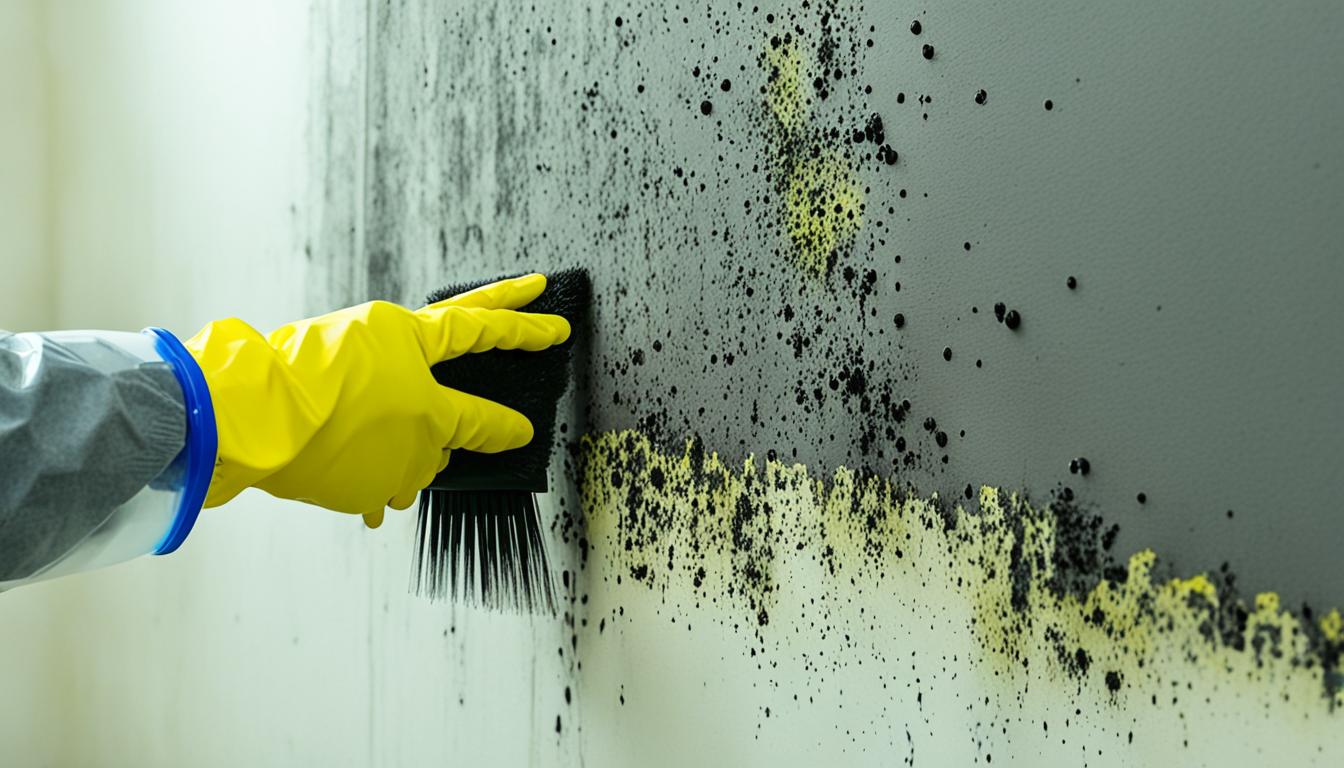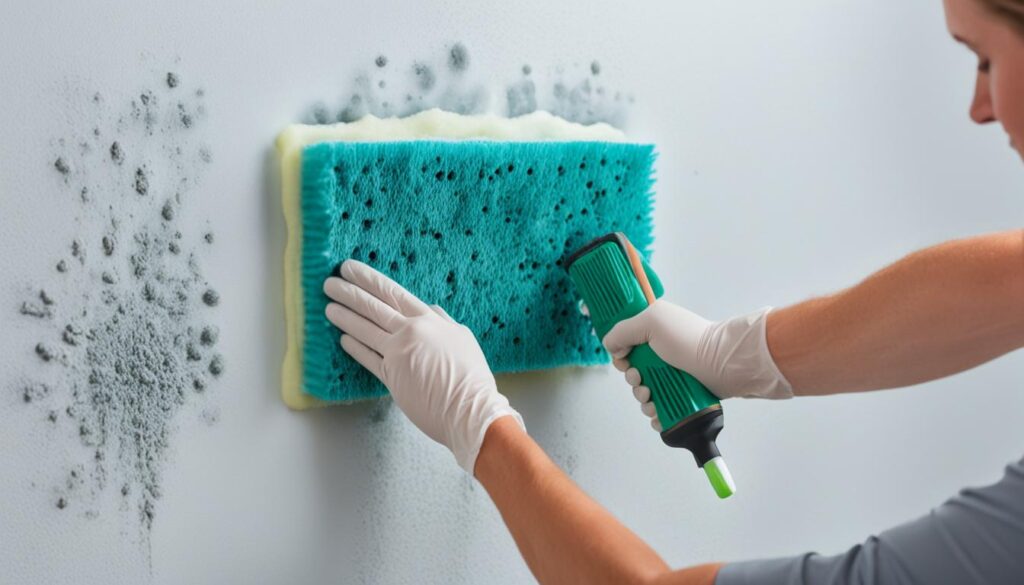
Mold Removal Guide: How to Clean the Mold Safely
Welcome to our comprehensive mold removal guide, where we will provide you with step-by-step instructions on how to clean mold safely in your home. Mold infestations can be a serious issue, posing health risks and compromising the safety of your living environment. By following the proper mold removal techniques, you can ensure a clean and healthy space for you and your family.
Mold growth is a common problem in many households, often caused by excess moisture and poor ventilation. Not only can mold negatively impact the structural integrity of your home, but it can also lead to various health issues, especially for individuals with respiratory conditions or allergies.
In this guide, we aim to educate you on the dangers of mold infestation and provide you with effective strategies for safe mold cleaning. By understanding the importance of mold removal and following the recommended procedures, you can eliminate mold growth and create a healthier living environment for yourself and your loved ones.
Key Takeaways:
- Proper mold removal techniques are essential for maintaining a clean and healthy living environment.
- Mold infestations can lead to serious health risks, particularly for individuals with respiratory conditions.
- Identifying the source of mold growth and addressing it is crucial to prevent future infestations.
- Preparing the area and using the right cleaning products are key steps for safe and effective mold removal.
- Regular inspection and maintenance can help prevent mold growth and ensure a mold-free home.
Understanding the Dangers of Mold Infestation
When it comes to mold infestation, the importance of taking immediate action cannot be overstated. Not only can mold cause structural damage to your property, but it also poses significant health risks. Mold spores, which are tiny airborne particles released by mold colonies, can trigger a range of respiratory issues when inhaled.
Exposure to mold spores can lead to nasal congestion, coughing, wheezing, and throat irritation. Individuals with pre-existing respiratory conditions, such as asthma or allergies, may experience more severe symptoms. Prolonged exposure to mold spores can even result in chronic respiratory conditions and other health complications.
“Mold spores can cause allergic reactions and respiratory problems, especially in vulnerable populations,” warns Dr. Emily Roberts, a renowned allergist.
The Link Between Mold and Health Risks
It’s important to note that not all molds are equally harmful, but certain types, such as Stachybotrys chartarum (black mold), are known for producing mycotoxins. These toxic substances can lead to more severe health issues, including neurological symptoms, fatigue, and even organ damage in extreme cases.
Furthermore, the presence of mold can exacerbate existing respiratory conditions and allergies, making it crucial to address mold infestation promptly. By understanding the potential dangers of mold and mold spores, you can take the necessary steps to protect your health and the well-being of your loved ones.

To effectively tackle mold infestation, it is crucial to employ safe and efficient mold removal procedures. In the following section, we will provide you with a comprehensive step-by-step guide on how to clean mold safely, ensuring a mold-free and healthy living environment for you and your family.
Step-by-Step Guide: How to Clean the Mold
Mold can pose serious health risks and damage your home if left untreated. To ensure safe mold removal and protect your health, follow this step-by-step guide on effective strategies for mold cleaning.
Step 1: Identify and Assess the Mold
To begin the mold cleaning process, carefully inspect your home for any visible signs of mold. Common areas where mold tends to grow include damp basements, bathrooms, and areas with poor ventilation. Look for discoloration, musty odors, and visible growth.
Take note of the extent of the mold infestation and identify any underlying issues that may contribute to its growth, such as water leaks or excessive humidity. It’s important to understand the scope of the problem before proceeding with mold removal.
Step 2: Prepare the Area for Cleaning
Prior to cleaning the mold, take appropriate precautions to protect yourself and prevent the spread of mold spores. Wear protective gloves, goggles, and a mask to avoid direct contact with mold and inhalation of spores.
Next, isolate the contaminated area by sealing off adjacent rooms with plastic sheets and tape. This containment will help prevent cross-contamination during the cleaning process.
Step 3: Choose the Right Cleaning Products
Not all cleaning products are effective against mold, and some may even exacerbate the problem. Opt for safe and specialized mold cleaning products that are designed to eliminate mold at its source.
Bleach, although commonly used for mold removal, is not recommended as its effectiveness is limited, and it may release harmful fumes. Instead, look for EPA-approved mold cleaners or natural alternatives such as vinegar or hydrogen peroxide.
Step 4: Safely Remove the Mold
Using a scrub brush or sponge, apply the chosen cleaning solution to the affected area. Remember to work in small sections and thoroughly clean each area before moving on to the next.
Gently scrub the mold-infested surface, ensuring you remove all visible mold. Dispose of any cleaning materials, such as brushes or sponges, used during the process to prevent spreading spores.
To ensure proper mold removal, focus not only on visible mold but also on hidden areas where mold could be growing, such as behind walls or under carpets. If the mold infestation is extensive, consider seeking professional assistance for thorough remediation.
Remember, as you clean the mold, avoid using high-pressure methods such as sanding or power washing, as these can release a large number of mold spores into the air and further contaminate your home.

Once the cleaning is complete, it is crucial to address the underlying cause of the mold growth to prevent future infestations. Repair any leaks, improve ventilation, and maintain low humidity levels in your home.
By following these step-by-step instructions and implementing safe mold removal practices, you can effectively eliminate mold and create a healthier living environment for you and your family.
Conclusion
Keeping your home mold-free is crucial for maintaining a safe and healthy living environment. Throughout this guide, we have highlighted the importance of safe and effective mold removal practices. By following the step-by-step instructions and implementing the strategies discussed, you can successfully eliminate mold and prevent its return.
Remember, mold infestations pose significant health risks, such as respiratory issues and allergic reactions. It is essential to address mold problems promptly and take the necessary precautions to protect yourself and your family.
When cleaning mold, always wear protective gear, such as gloves and a mask, to minimize exposure to mold spores. Use appropriate cleaning products and ensure proper ventilation in the affected area. Additionally, proper mold prevention measures, such as controlling moisture levels and improving ventilation, can help prevent future mold growth.
By prioritizing safe mold removal practices and staying vigilant against mold infestations, you can ensure a clean and healthy home environment for you and your loved ones.




